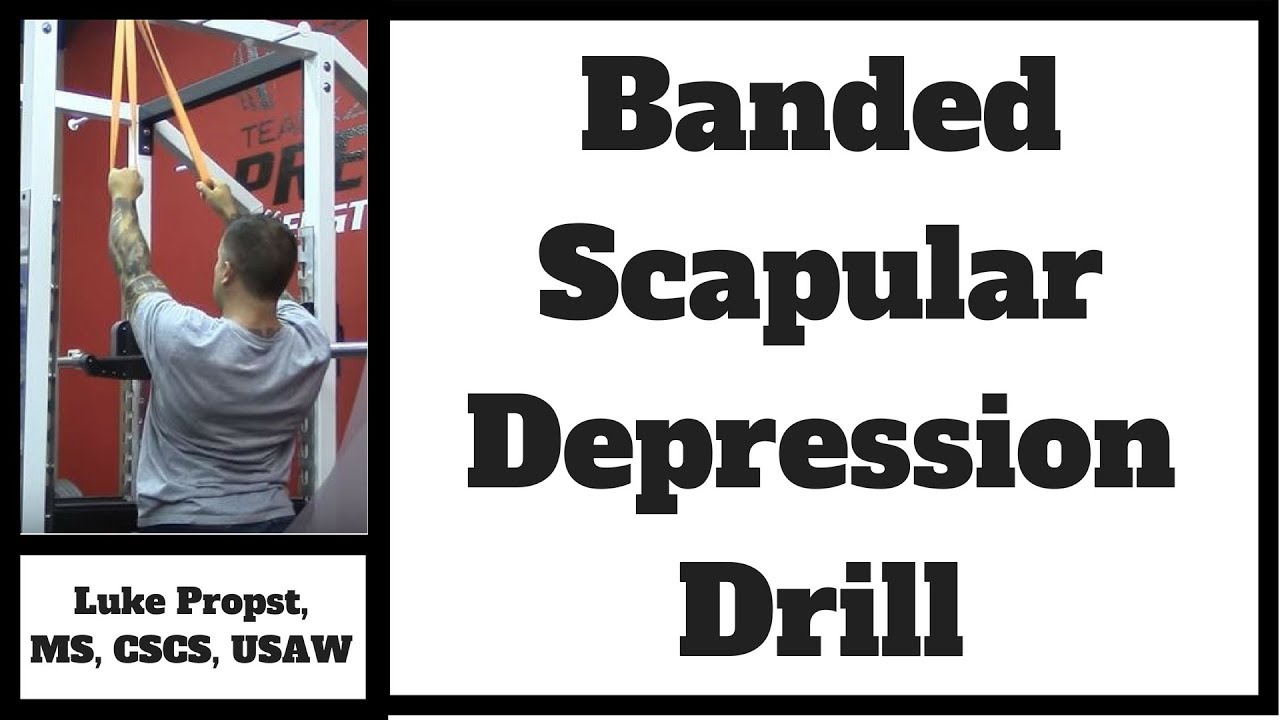
Scapular depression exercises strengthen shoulder blade muscles. They enhance posture and shoulder stability.
Scapular depression exercises are designed to target the muscles responsible for pulling the shoulder blades downward. These exercises play a crucial role in improving overall shoulder function and can be terrific for individuals who experience shoulder pain or those who are looking to improve their upper body strength.
Incorporating scapular depression movements into your workout routine may lead to better posture, decreased neck tension, and enhanced range of motion. Regular practice of these exercises can be particularly beneficial for athletes, desk workers, or anyone susceptible to shoulder issues due to poor posture or repetitive strain. With consistent training, you can expect a reinforcement of the supporting musculature around the scapula, ultimately contributing to a stronger and more resilient upper back.
The Connection Between Exercise And Mental Health
Regular exercise does wonders for your physical well-being. It strengthens the heart, improves circulation, and can even reduce the risk of certain diseases. But its benefits extend far beyond the body. Physical activity has a significant impact on our mental health, too. From lifting your mood to helping combat depression, it’s a powerful tool for enhancing your overall quality of life.
How Physical Activity Influences Mood
When you engage in physical activity, your body releases chemicals called endorphins. These are natural mood lifters. They act as the body’s built-in painkillers and happiness boosters. Exercise also promotes the release of other beneficial brain chemicals, such as:
- Serotonin: Regulates mood, sleep, and appetite
- Dopamine: Plays a key role in how we feel pleasure
- Norepinephrine: Affects attention and responding actions
It’s not just chemical; it’s behavioral, too. Exercise helps break negative thought patterns and can pull you out of the downward spiral of depression. By setting exercise goals and achieving them, you boost your self-esteem as well.
Scientific Insights Into Exercise And Depression
Studies show a strong link between exercise and the reduction of depression symptoms. Exercise acts as a natural anti-depressant. Research findings indicate that:
| Activity Level | Impact on Depression |
|---|---|
| Mild to moderate exercise | May improve depression symptoms |
| Regular moderate to high-intensity exercise | Lowers depression risk |
Participating in regular, structured exercises reduces the risk of developing depression by up to 30%. Even simple lifestyle activities, like gardening or walking, can make a difference.
Scientists believe that exercise can create a buffer against stress, which is often a precursor to depression. Furthermore, exercise encourages new neuron growth in the brain, which is vital for mental health.
Recognizing Scap Depression
Scap depression often goes unnoticed. Knowing how to spot it is key to maintaining shoulder health. It’s when your shoulder blades, or scapulae, move downward. Strong, healthy shoulder blades support your arms and upper body.
Symptoms And Signs
Identifying scap depression involves noticing subtle changes.
- Persistent shoulder pain
- Weakness in the arms
- Difficulty lifting objects
- Poor posture
These signs might point to scap depression. Don’t ignore them. They can lead to more issues if not addressed.
The Role Of The Scapula In Physical Health
The scapula or shoulder blade is a cornerstone for upper body strength. It supports arm mobility. A well-positioned scapula prevents injuries. It ensures muscles work efficiently.
A depressed scapula can cause tightness and imbalance. This impacts how your body moves. Keeping the scapula propped up takes effort and awareness.
| Function | Importance |
|---|---|
| Stability | Keeps shoulder joint secure. |
| Mobility | Enables a wide range of arm movements. |
| Protection | Shields back muscles and spine. |
| Strength | Empowers lifting and pushing actions. |
Types Of Exercises For Scap Depression
Engaging in targeted exercise is vital for enhancing shoulder stability and alleviating discomfort. Scapular depression, focusing on lowering the shoulder blades, can improve posture and reduce pain. Specific exercises that emphasize scap depression can fortify muscles, boost endurance, and aid mental health.
Strengthening And Mobility Workouts
Building muscle around the shoulder blades is crucial for scap depression. Strengthening and mobility are two sides of the same coin when it comes to shoulder health.
- Lat Pulldowns: Sit, pull the bar down to chest level.
- Scapular Push-Ups: In a push-up position, keep arms straight, lower and raise shoulder blades.
- Wall Slides: Stand, slide arms up and down against a wall.
Adding routines that address flexibility further enhances joint mobility. Pairing strength with flexibility leads to optimal results.
- Yoga: Poses like Downward Dog work on both strengthening and stretching.
- Doorway Stretch: Stand in a doorway, stretch arms on the frame, lean forward.
- Cat-Cow Pose: On hands and knees, arch and round your back.
Endurance Exercises For Mental Health
Mental health benefits from consistent physical activity. Endurance exercises can boost mood and reduce stress.
- Swimming: A low-impact exercise that builds endurance and mental calm.
- Cycling: Excellent for heart health and an endorphin release.
- Brisk Walking: Simple and effective, it promotes cardiovascular fitness.
Combining these exercises into a weekly routine will contribute to both physical and mental well-being.

Credit: www.youtube.com
Targeted Scapular Exercises
Welcome to our guide on ‘Targeted Scapular Exercises’. A strong, flexible scapula is the cornerstone of a healthy shoulder. These exercises aim to fortify scapular muscles and enhance their range of motion. A sturdy scapula supports the arm and maintains posture. Ready to dive in?
Improving Scapular Stabilization
A stable scapula sets the stage for shoulder movements. Strong scapular stabilization is required for lifting, pulling, and pushing actions. Here are exercises to improve stabilization:
- Wall Slides: Stand against a wall, slide arms upward, maintain contact.
- Planks: Hold a plank position, keep scapulae down and back.
- Prone Ys: Lie down, lift arms in ‘Y’ shape, squeeze shoulder blades.
Perform these regimens three times weekly. Aim for two to three sets of ten repetitions.
Enhancing Scapular Upward Rotation
Scapular upward rotation is crucial for reaching overhead. It allows elevation without injury. Exercises to improve this motion include:
- Shoulder Shrugs: Lift shoulders towards ears, hold, and release gently.
- Scaption: Raise arms at a 45-degree angle, thumbs up, shoulder-height.
- Wall Angels: Back against wall, move arms up and down, forming a ‘W’.
Consistency is key. Perform at least twice a week for optimal results.
| Day | Stabilization Work | Upward Rotation Work |
|---|---|---|
| Monday | Wall Slides, Planks | Shoulder Shrugs |
| Wednesday | Prone Ys | Scaption |
| Friday | Planks, Prone Ys | Wall Angels |
Exercise Routines To Combat Depression
Fighting depression takes strength, but exercise can be a powerful ally. Regular physical activity boosts endorphins—natural mood lifters. It’s not about running marathons. Simple, consistent exercises can brighten the outlook. Let’s build an effective exercise routine for beating depression.
Creating A Sustainable Workout Plan
Create a routine you’ll stick with. Remember, small steps lead to big victories. Start slow with these tips:
- Set realistic goals: Aim for achievable milestones.
- Choose activities you enjoy: Love dancing? Make it a workout!
- Keep it regular: Consistency is key for mood improvement.
- Track progress: Celebrate each success to stay motivated.
| Day | Activity | Duration |
|---|---|---|
| Monday | Walk or jog | 30 minutes |
| Wednesday | Yoga or stretching | 30 minutes |
| Friday | Swimming or cycling | 30 minutes |
Incorporating Mindfulness And Relaxation Techniques
Exercise isn’t just about the body. It’s about the mind. Add these techniques to maximize benefits:
- Breathe deep: Inhale peace, exhale stress.
- Stretch with intention: Focus on the feeling in each muscle.
- Guided meditation: Finish a workout with calm.
Try yoga or tai chi: These mix movement with mindfulness for double the impact. Consider these routines:
- Yoga:
- Sun Salutation – Start your day with positivity
- Tai Chi:
- Five Elements Qigong – Balance your energy

Credit: www.researchgate.net
Adapting Exercises For Different Fitness Levels
Exercising can boost mental health, including easing symptoms of depression. Scalp depression exercises, often linked with focused breathwork and mental concentration, are an excellent way to alleviate stress. Tailoring these exercises to suit your fitness level ensures a safe and effective workout.
Modifications For Beginners
Starting a new exercise regimen can be challenging, but beginners can adapt easily. Scalp depression exercises for novices should focus on gentle movements and slow progression. Here are simple ways to modify these exercises:
- Reduce the range of motion: Don’t push your scalp too hard; gentle presses are sufficient.
- Limit the duration: Start with short sessions and gradually increase as you get comfortable.
- Use assistance: Utilize props like soft cushions to support your neck and head during the exercise.
- Monitor your breathing: Ensure you breathe slowly and deeply to complement the movements.
Advanced Scalp Depression Movements
For those with a higher fitness level, advanced scalp depression exercises incorporate more complex techniques.
| Exercise | Technique | Duration |
|---|---|---|
| Isometric Holds | Press and hold the scalp in a depressed state | 30 seconds |
| Pulsing Techniques | Rapidly depress and release scalp muscles | 1-2 minutes |
| Scalp Slides | Slide the scalp forward and backward while maintaining depression | Repeat 10-15 times |
| Resistance Training | Apply gentle pressure with the hand while depressing the scalp | Repeat 10-15 times |
Including these advanced methods will challenge your mental focus and enhance the exercise’s effectiveness. Always listen to your body and not push beyond comfort.
Monitoring Progress And Adjusting Routines
Working on Scap Depression Exercises can be vital for mental and physical health. To see benefits, it’s key to keep track of your improvements. This means Monitoring Progress and Adjusting Routines, which helps tweak workouts for better outcomes. Let’s explore how to set achievable goals and know when it’s time to level up your exercise routine.
Setting Realistic Goals And Expectations
Goals give you a target to hit. When starting with Scap Depression Exercises, think small. Over time, small wins build big successes. Use these steps:
- Define clear, attainable goals.
- Break goals into weekly milestones.
- Track daily progress.
- Be patient and consistent.
Remember, progress takes time, so don’t push too hard, too fast. Let’s look at when – and how – to safely ramp up your routine.
When And How To Intensify Your Routine
As you get stronger, you’ll need to make exercises harder. This keeps your body challenged. Below are signs you’re ready:
| Signs You’re Ready to Intensify |
|---|
| Exercises feel easier than before |
| Not feeling the same muscle engagement |
| Reaching goals faster than expected |
When you notice these, try new steps:
- Increase repetitions or sets.
- Add weight or resistance.
- Reduce rest intervals between sets.
Attempt these changes gradually. This will protect against overworking muscles. Always listen to your body, and rest if it tells you to stop.
Embracing A Holistic Approach To Mental Health
Embracing a Holistic Approach to Mental Health means looking at all parts of our lives. It’s not just about the thoughts in our heads. It’s also about what we eat, how we move, and who we talk to for help. Imagine a puzzle. One piece might be therapy, but other pieces like food and friends are just as important. Let’s put together this puzzle for a happier, healthier mind.
Nutrition And Lifestyle Factors
Good food and habits are like fuel for the brain. They make a big difference in how we feel. Here’s a simple guide:
- Eat whole foods: These are foods not in a box. Think fruits, vegetables, and grains.
- Stay active: Moving around is good for the brain. It can be anything from walking to dancing.
- Get enough sleep: When we sleep, our mind gets a break and heals.
Treating our bodies right helps our minds too. It’s like two friends helping each other.
Connecting With Professional Support
Sometimes, talking to someone who knows a lot about feelings helps. Here’s how to start:
- Find a good listener: This could be a therapist or counselor.
- Be open: Tell them what’s going on in your life. No secrets.
- Keep going: Sometimes it’s hard, but stick with it. It’s worth it in the end.
Getting help from a professional is brave. It’s a big step towards feeling better.

Credit: m.facebook.com
Frequently Asked Questions On Scap Depression Exercises
What Are Scap Depression Exercises?
Scap depression exercises involve movements that focus on lowering the shoulder blades. These exercises help improve shoulder stability and can alleviate tension in the upper back.
Can Scap Depression Ease Neck Pain?
Yes, scap depression exercises can alleviate neck pain. By strengthening the shoulder blades’ supporting muscles, tension in the neck region is often reduced.
How Often Should You Perform Scapular Depression?
For best results, scapular depression exercises should be performed 2-3 times per week. Consistency helps in muscle strengthening and improving shoulder mobility.
Are Scap Depression Exercises Safe For Everyone?
Scap depression exercises are generally safe but should be performed properly to avoid injury. Individuals with shoulder issues should consult a healthcare professional before starting any new exercise regimen.
Conclusion
Embracing the power of escapism through exercise offers a natural and empowering approach to combat depression. Consistent participation in escapist activities not only boosts mood but also fosters a sense of personal control. Remember, your mental health journey is yours to navigate, and incorporating these exercises could be a transformative piece of the puzzle.
As you integrate these methods, may you find the strength and serenity you deserve.







